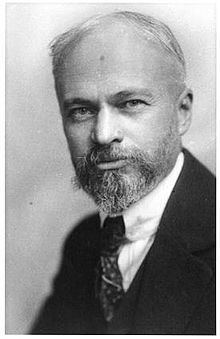Nationality American Role Jr. Citizenship United States Parents Harrison Gray Dyar | Years active 1889–1929 Known for Scientist, Entomology Name Harrison Dyar, | |
 | ||
Born February 14, 1866 ( 1866-02-14 ) New York City, U.S.A. Residence Washington, D.C., U.S.A. Alma mater Died January 21, 1929, Washington, D.C., United States Books The Mosquitoes of the United States Grandparents Susanna Wild, Jeremiah Dyar Education Columbia University, Massachusetts Institute of Technology | ||
Harrison Gray Dyar Jr. (February 14, 1866 New York City – January 21, 1929, Washington, D.C.) was an American entomologist.
Contents
Early life
He was a son of Harrison Gray Dyar and his wife Eleonora Rosella (née Hannum). Dyar graduated from Massachusetts Institute of Technology in 1889 with a Bachelor of Science degree in chemistry. He had begun to study insects as a young teenager, and soon after his graduation from college began publishing scientific papers about them, in particular moths of the family Limacodidae, starting a lifelong interest in entomology. He was awarded a Master of Arts degree in biology from Columbia University in 1894, with his thesis on the classification of Lepidoptera, and a Doctor of Philosophy degree in 1895, with his dissertation on airborne bacteria in New York City.
Taxonomy
Dyar was a taxonomist who published extensively on moths and butterflies (Lepidoptera), mosquitoes (Diptera: Culicidae), and sawflies (Hymenoptera: Symphyta) during his working lifetime. His first job was as Assistant Bacteriologist of the College of Physicians and Surgeons of Columbia University from 1895 to 1897. From 1897 until his death he was Honorary Custodian of Lepidoptera at the U.S. National Museum, Washington, D.C. Dyar was independently wealthy and for a major part of his 31 years at the USNM he worked without compensation; his independence also made it possible for him to travel and collect extensively within North America.
Dyar's Law, a biological rule named for him in recognition of his original observations on the geometric progression in head capsule widths during lepidoptera larval development, is a standard tool for studying immature insects. An earlier publication in 1886 by W.K. Brooks independently described the same phenomenon in crustaceans, and therefore the variant term "Brooks-Dyar Law" (or "Brooks Rule" or "Brooks-Dyar Rule") also commonly appears in the literature.
Dyar was editor of the Journal of the New York Entomological Society from 1904 to 1907 and of the Proceedings of the Entomological Society of Washington from 1909 to 1912; from 1913 to 1926 he published and edited his own taxonomic journal, Insecutor Inscitiae Menstruus. Dyar and Frederick Knab were primarily responsible for the taxonomic portions of The Mosquitoes of North and Central America and the West Indies, published, with co-author L. O. Howard, in four volumes from 1912–1917.
Dyar was also noted for his intellectual and at times acerbic exchanges with fellow entomologists, for example, in correspondence with Clara Southmayd Ludlow. Dyar engaged in "protracted, spectacularly belligerent feud with fellow entomologists".
In 1924, Dyar was commissioned a captain in the Sanitary Department of the U.S. Army Reserve Officers Corps because of his background in the study of mosquitoes.
Personal
Dyar was a bigamist, "for fourteen years he was married to two women, maintaining two families with five children in all." He married Zella M. Peabody of Los Angeles, a music teacher in 1889. They had two children. This marriage ended in 1920. But in 1906, using the alias of Wilfred P. Allen, Dyar married Wellesca Pollock. In 1921, now divorced from Peabody, Dyar legally married Pollock; they had three sons.
Pollock was an educator and ardent disciple of the Bahá'í Faith. After his legal marriage to Pollock, Dyar became active in the Bahá'í Faith, and edited an independent Bahá'í journal, Reality, from 1922 until his death.
During the 1920s, Dyar's hobby of tunnel-building was discovered when a truck broke through into a labyrinth of tunnels near his former home in Washington, D.C.
Dyar was a second cousin of American Civil War soldier and publisher Harrison Gray Otis.
